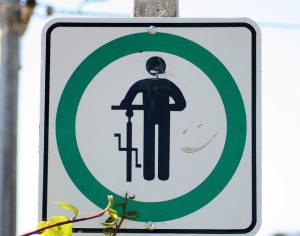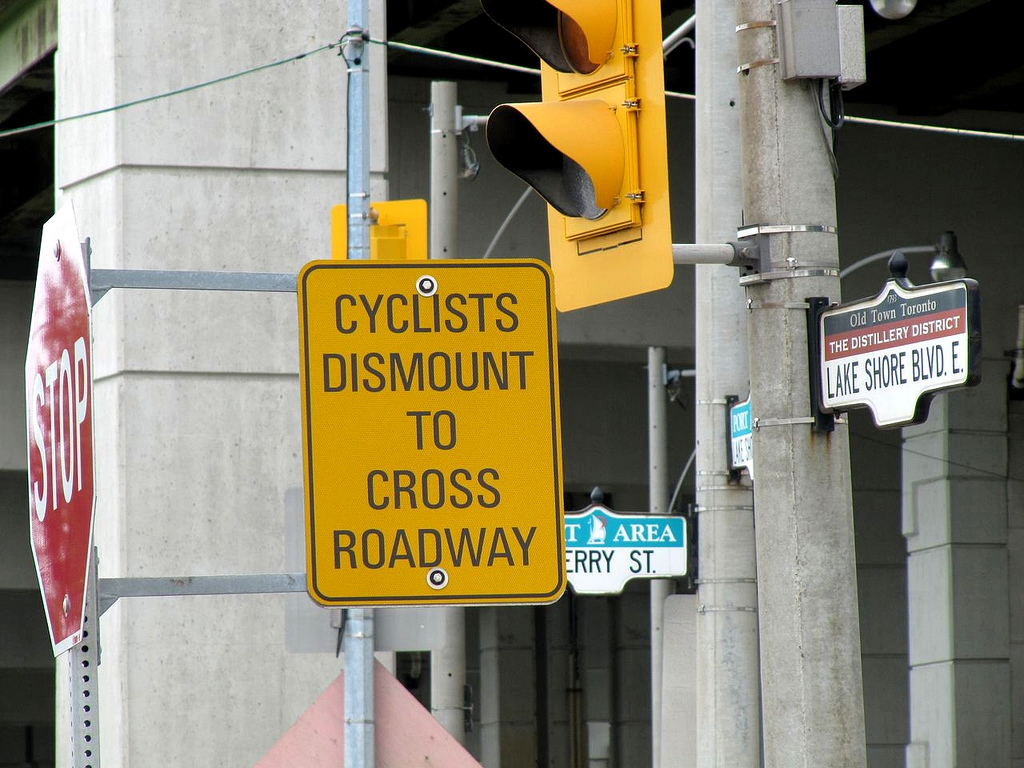Regional staff think they can reduce bike crashes with ‘cyclist dismount’ signs. Provincial guidelines say that’s a bad idea.
It’s no surprise that over half of all collisions between bikes and cars take place in crosswalks. It’s partly why our local municipalities have opted to prohibit sidewalk cycling in their bylaws.
Some might argue it’s the victim’s own fault if they’re struck while biking in a crosswalk, as they’re willfully breaking the rules of the road. But when it comes to other issues of public health, such as smoking, substance abuse, or even sedentary lifestyles and poor diets, we don’t allow a person’s choices to prevent us from trying to protect them from unnecessary illness, injury, or death.
Preventing traffic violence should be no different. In fact, traffic engineers recognize that they can’t just expect drivers to perfectly follow speed limits or obey signs to protect themselves, but have to apply good design and analysis to protect drivers from their own mistakes, (not to mention their passengers or others on the road). This may involve changing the environment so that mistakes are less deadly, or changing the factors which influence people to make those mistakes in the first place.
Each year as part of the Region’s collision report, the top locations for crashes are determined for people driving, walking, and biking, and countermeasures are considered to try to reduce frequently encountered types of collisions. For top collision locations for cars, changes including conversions to roundabouts, addition of left turn lanes, and dedicated turning phases are considered. For many of the top locations where people walking are struck, better lighting, countdown timers, more visible markings, and crosswalk relocation are all on the table. For King and Cedar, where several people biking with the sharrows have been struck by turning cars, staff are considering restricting certain turns.

This sign is used to tell people biking to dismount and walk, which the Ontario Traffic Manual discourages. Photo (C) 2011 Richard Masoner on Flickr, licensed under CC-BY-SA.
But when it comes to people getting hit by cars while biking in crosswalks, it seems the best staff think they can do is put up a bunch of ‘cyclist dismount’ signs.
The province’s bicycle facility guidelines discourage installing ‘dismount’ signs because they aren’t frequently obeyed, and worse, can influence people to ignore other signs and signals:
“The option of asking cyclists to dismount and walk their bikes should not be relied upon in lieu of adequately accommodating cyclists through appropriate road design. Being propelled by muscular power, cyclists more than other vehicle operators will prefer to sustain their momentum and avoid stopping. Cyclists usually find it difficult to rationalize why “dismount and walk” restrictions are in place, and conclude that they were a poor, illogical or arbitrary decision. Thus, if facility designs cause cyclists to make what they consider to be unnecessary stops, this will increase the likelihood that they will ignore or disobey traffic controls, which breeds disrespect for these devices.”
— Ontario Traffic Manual Book 18, 1.5 Cycling Myths, page 9
There are several other important reasons why putting up dismount signs aren’t a great idea:
- It ignores the real source of the problem. Many of these collision locations are terrible places to bike, leading many to conclude that it’s safer for them to use the sidewalk than the road. Protected bike lanes along these roads, coupled with good intersection design would go a long way towards improving safety.
- It implies cycling on the sidewalk is otherwise acceptable. Putting up signs for cyclists who are on sidewalks would suggest they are expected to be there, which isn’t the case. Even if people biking obeyed the signs and walked their bikes, there would still be conflicts between people walking and biking on sidewalks.
- It’s not a viable solution for when sidewalks are changed to multi-use trails. The Region is increasingly looking to using wider multi-use trails in place of sidewalks and bike lanes on busy roads with no driveways. One of the top collision locations, Ottawa at the Laurentian Power Centre entrance, is expected to get multi-use paths sometime around 2020. If we are going to build pathways along roads, we need to design intersections to accommodate people who bike, not effectively ignore them.
Sometimes, paying attention to the actual factors that change behaviour and influence collisions is hard, and putting up signs can make us feel like we’re doing something. Preventing people from being struck by cars in crosswalks requires more than just tsk-tsking them for not dismounting from their bikes, but appropriate infrastructure with good design to accommodate them. We hope to find better solutions in future collision reports.
Headline photo (C) 2010 James Schwartz on Flickr, licensed under CC-BY-ND 2.0.


The sign with a green circle means that is allowed, not that something is prohibited. If cyclists were required to dismount, the sign would show a mounted cyclist with a red circle with a diagonal red slash through it. Generally a cyclist has the option of dismounting anywhere at anytime, and legally becomes a pedestrian, so that sign is redundant.
Cyclists cause accidents when they come off sidewalks into roadway traffic because other vehicles do not expect them to be there especially at a high speed.
Thanks for your comment. It may look like a permissive-type sign, but Ontario Traffic Manual Book 18 refers to this particular sign as the “dismount and walk” sign:
“Consequently, the Dismount and Walk sign Rb-70 (OTM), shown in Figure 4.93 should be used only in exceptional cases, such as where an in-boulevard facility ends, and cyclists would discharge into a sidewalk or pedestrian zone.” (Dismount and Walk Sign, 4.4.1.2 Signs, p. 118)